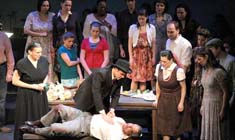I first saw Frank Loesser’s “The Most Happy Fella” in 1957, during its first Broadway run. I bought the score as soon as it was published and the original cast album (the first recording of an entire show, including spoken dialogue) as soon as the 33rpm records came out. These were later replaced by CD’s. In 2006 I attended the New York City Opera’s disastrous production starring a woefully miscast, musically inept Paul Sorvino as the baritone lead. There were other revivals in between. Yes, I’ve had a fifty-five year love affair with this great American musical, but it was a love affair scarred by inept revivals. Would I ever experience a performance which came even close to my memories of the original? This thought went through my mind as I sat in the fifth row of the Dicapo Opera Theatre’s lovely 204 seat space in the basement of St. Jean Baptiste Church on E 76th Street. As the houselights dimmed I was in a state of wary anticipation.
And a few hours later, I was in a state of bliss. I had just attended a performance for which I am still finding it hard to find suitable words – superb, magnificent, sublime all come to mind. Forget about 1957 – this was the best performance I’ve heard of this great American masterpiece; the perfect amalgam of wonderful unamplified singing (both operatic and pop,) moving acting, clear and simple staging, costumes which conjured up a time and a place, and beautiful orchestral playing.
“The Most Happy Fella” stands or falls on the performance of the “fella,” Tony Esposito, a lonely Italian immigrant who owns a winery in the Napa Valley. He is most often played by a large man who often exaggerates the characters awkwardness and lack of education. Baritone Michael Corvino is a slight, dignified man and his moving portrayal brought out the character’s fragility and, more than any Tony I’ve seen, his deep love for Rosabella, the mail-order bride who has come to his winery. He is a powerful and compelling baritone. But one never felt that he was an “opera singer” crossing over into musical comedy, as he brought the same natural delivery to his “arias” as he did to simple songs like “Happy to make your Acquaintance.” And there was a wonderful chemistry between Mr. Corvino’s Tony and soprano Molly Mustonen’s Rosabella. Possessing a beautiful soprano voice, Ms. Mustonen is a fine singing actress. Her deepening love for Tony was palpable and brought tears to my eyes.
But if much of the music sung by Tony and Rosabella tended towards the operatic, that of the two other leads, Lauren Hoffmeier and Brance Cornelius, was pure musical comedy. Ms. Hoffmeier’s singing of the show’s first number, “Ooo! My Feet,” was deliciously brassy, and her duet with Mr. Cornelius, “Big D,” brought down the house. The fine dancing of both these performers helped choreographer Francine D. Harman solve the problem of how an opera company treats the show’s two big dance numbers. The members of Dicapo’s chorus sang beautifully all evening, but couldn’t be expected to perform the complex choreography of big production numbers. Ms. Harman’s solution was perfect. Omit the dance following the chorus “Sposalizio” and leave most of the dancing in “Big D” to Ms. Hoffmeier and Mr. Cornelius. By the way, the chorus’s performance of “Song of a Summer Night” was memorable.
The supporting cast did much more than just support. One could not ask for better portrayals than Peter Kendall Clark’s Jo, Bess Morrison’s Marie, Michael Hopewell’s Doc and David Keller-Flight’s Postman. Three show stoppers were “Standing on the Corner,” performed by Brian Ribeiro, Nicholas Connolly, Jonathan Harris and the afore mentioned Brance Cornelius; “Abbondanza,” and “Benvenuta,” brilliantly sung by Paolo Buffani, Michael Imbimbo and Vincent Ricciardi.
The fine orchestra was under the masterful direction of conductor Pacien Mazzagatti. The orchestra was seated upstage, behind the performers, bringing the singers very close to the audience. But this setup did nothing to hinder the coordination between voices and instruments. The ensemble was perfect. The simple but effective set by John Farrell was beautifully lit by Susan Roth (In addition to what happened on stage, I loved the mysterious blue-lit orchestra behind the performers.) The fine costumes were designed by Julie Wyma.
Kudos to Dicapo Opera Theatre’s General Director, Michael Capasso. He has a smash hit show on his hands. My brother, who now lives in Paris, was with me at that 1957 performance of “The Most Happy Fella,” If Dicapo performs it again, he will fly back to New York to see it. I’ll be there too.

